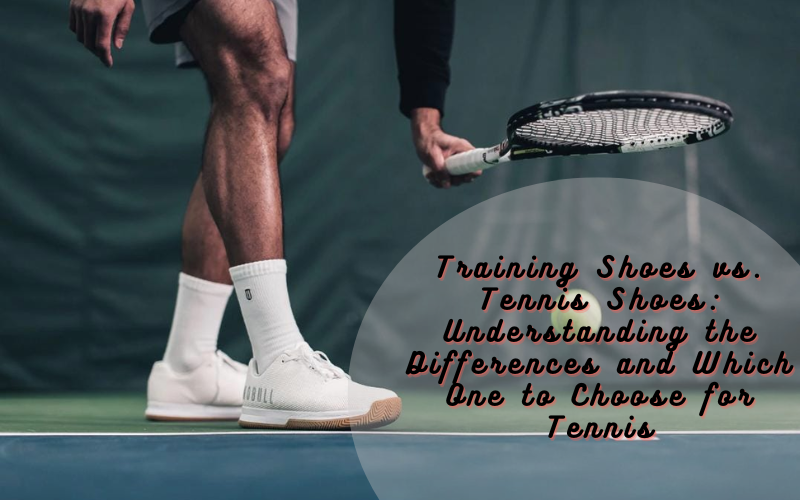If you play tennis regularly, you’re likely aware of the wear and tear that your tennis shoes experience. As a result, it’s important to replace them frequently. However, what many people may not realize is that their old training shoes can be repurposed for tennis. In this article, we’ll explore whether or not it’s okay to use training shoes for tennis, so you can make the most of your athletic gear. Let’s get started!
Table Of Contents
- Choosing the Right Footwear for Tennis: Can Training Shoes Meet Your Needs?
- FAQs
- Can Cross Training Shoes Be Used for Tennis?
- How can you identify if a shoe is suitable for playing tennis?
- Is Nike Metcon Suitable for Tennis?
- What Are The Key Differences Between Running Shoes and Training Shoes?
- What Are The Key Differences Between Tennis Shoes And Running Shoes?
- What are the benefits of using training tennis shoes?
- Is a Tennis Shoe Considered a Sneaker?
- Conclusion
Choosing the Right Footwear for Tennis: Can Training Shoes Meet Your Needs?
Yes, training shoes can be used for tennis, but they are designed for clay courts rather than hard courts. This makes them more flexible and provides more traction on clay. However, it doesn’t mean that they cannot be used on hard courts at all. If you’re a casual player, you can wear these shoes, but for competitions, it’s best to use the proper gear.
Since tennis is an active sport that requires a lot of movement, proper footwear is crucial for optimal performance. The better your form and movement, the greater your chances of success. Professional tennis shoes offer the right support to prevent injuries and protect your feet from natural barriers such as wind, soil, or uneven terrain. So, it’s important to choose the right footwear for your level of play and specific needs.

FAQs
Can Cross Training Shoes Be Used for Tennis?
Cross-training shoes are not the most ideal option for playing tennis, but it is possible to use them if you choose the right pair. These shoes are designed to be versatile and durable, but you should still prioritize comfort to avoid any unnecessary injuries. While they may look relatively normal, they are not intended to be your primary tennis shoes.
If you are serious about playing tennis, it’s best to invest in footwear that is specifically designed for the sport. While these shoes may come with a higher price tag, they are tailored to provide the best support, traction, and stability that you need to excel on the court. Ultimately, choosing the right footwear can have a significant impact on your performance and overall experience playing tennis.
How can you identify if a shoe is suitable for playing tennis?
To help you choose the right footwear for your tennis game, it’s important to understand the differences between training shoes and tennis shoes. One key difference is that tennis shoes have more cushioning to support the various movements involved in playing, such as reaching, jumping, and moving side to side. Another difference is that tennis shoes have a more snug fit, with less room in the front of the shoe, to provide stability during lateral movements.
On the other hand, training shoes typically have a roomier toe box to allow for wider foot placement, as they are designed for more general gym or cross-training activities. While training shoes can be used for tennis, they may not offer the same level of support and stability as tennis shoes, which could increase the risk of injury during the game.
Is Nike Metcon Suitable for Tennis?
There are varying opinions on whether Nike Metcon shoes are suitable for tennis players. Some people believe that these shoes are not designed for tennis because they are primarily intended for running and lifting. However, there are also some advantages to using them for tennis.
Wearing Nike Metcon shoes while running can help strengthen your muscles, enabling you to jump higher and hit the ball with more force. Additionally, the soles on these shoes are designed to provide support to the feet in the right places, which can benefit tennis players. Ultimately, the decision to wear these shoes for tennis will depend on personal preference and comfort, as well as the individual’s playing style and needs.
What Are The Key Differences Between Running Shoes and Training Shoes?
To clarify, running shoes and training shoes are not the same thing, despite many people thinking they are. Running shoes are specifically designed to handle the unique stresses that come with running, while training shoes are built to facilitate a variety of movements and encourage more efficient movement patterns. Although both types of shoes aim to help you stay active and healthy, they do so in distinct ways that cater to different types of physical activity.

What Are The Key Differences Between Tennis Shoes And Running Shoes?
When it comes to comparing tennis and running footwear, there are some key differences. Tennis shoes tend to be lighter in weight than running shoes, which can make them ideal for playing tennis since they allow for fast movements on the court. However, this also means that they have less support than running shoes, which are made with thicker rubber and more cushioning to handle the stress that running puts on the feet and body. While tennis shoes may work well for playing on the court, they may not provide enough cushioning and support for running on rough terrain like rocky trails or asphalt. So, it’s important to choose the right footwear for the specific activity you plan to do to avoid injury and maximize performance.
What are the benefits of using training tennis shoes?
Tennis footwear is designed to cater to the specific needs of players while playing the game. They are created with the right weight to provide comfort and to allow swift movements on the court. Additionally, the rubber soles of these sneakers are designed to provide ample traction and support for players during the game. Some tennis footgear may also come with either removable or molded soles to cater to individual preferences.
Is a Tennis Shoe Considered a Sneaker?
To the average person, the difference between a sneaker and a tennis shoe used to be crystal clear. The common perception was that tennis shoes were not sneakers. However, with the evolution of the footwear industry, the distinction between the two is no longer as clear-cut. Nowadays, many shoes designed for tennis can be considered sneakers and vice versa.
Conclusion
We hope this article on using training shoes for tennis has been helpful. It’s essential to wear the right footwear when playing tennis, as it affects your performance and can prevent injuries. Take a look at the various training shoes available in the market to determine if they are suitable for playing tennis or if you should invest in a specific tennis shoe.
We wish you a fantastic time on the court, and have a great game!

